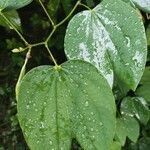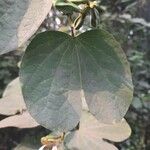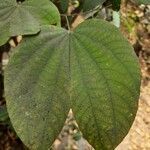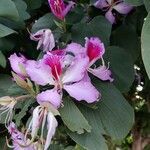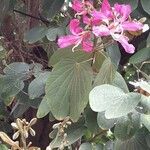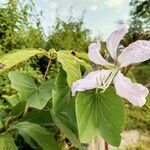Trees or erect shrubs, 7-10 m tall. Bark grayish to dark brownish, thick, smooth; branches puberulent when young, later glabrous. Petiole 3-4 cm; leaf blade suborbicular, 10-15 × 9-14 cm, stiffly papery, abaxially almost glabrous, adaxially glabrous, primary veins 9-11, secondary and higher order veins protruding, base shallowly cordate, apex bifid to 1/3-1/2, lobes slightly acute or rarely rounded at apex. Inflorescence a raceme with few flowers, or a panicle with up to 20 flowers, axillary or terminal. Flower buds fusiform, 4-or 5-ridged, with an obtuse apex. Pedicel 7-12 mm. Calyx open as a spathe into 2 lobes, one with 2 teeth and other 3-toothed. Petals light pink, oblanceolate, 4-5 cm, clawed. Fertile stamens 3; filaments ca. as long as petals. Staminodes 5 or 6, 6-10 mm. Ovary stalked, velvety; style curved; stigma slightly enlarged, peltate. Legume linear, flat, 12-25 × 2-2.5 cm; valves woody. Seeds compressed, suborbicular, 12-15 mm in diam. Fl. Sep-Nov, fr. next Feb-Mar. 2n = 28.
An evergreen shrub or small tree. It grows to 4-10 m high and spreads to 2 m across. The stem is erect and slender. The branches are crooked. The leaves are green and have 2 lobes which divide the leaves for half their length. They are rounded and 7-16 cm long and the same width. The leaf stalk is 3 cm long. The flowers are purple and orchid like. They are large and can be 6 cm across. They can occur either on their own or in flowering branches and can be in the axils of leaves or at the ends of branches. The flower buds are 4-5 angled. The flower petals are reddish purple and often with coloured marks. The petals do not overlap and there are 3-4 stamens. The fruit are oblong brown pods. They are flattened and can be 25 cm long by 2 cm wide. There are 5-6 seeds. The seeds are 12-13 mm long.
Introduced, unarmed, ornamental shrub, branchlets glabrous to lightly pubes-cent. Leaves broadly orbicular, cordate to truncate basally, usually prominently 9-veined, glabrous to lightly pubescent below, up to 13 cm. long and 16 cm. broad, shallowly cleft apically, lobes obtuse, rounded; petiole angled, callous-swollen apically and basally, up to 4 cm. long. Inflorescence terminal or subterminal,
several-to many-flowered. Flowers conspicuous, 3-4 cm. long; calyx scarcely spathaceous, tube up to 1 cm. long, limb up to 2.5 cm. long; petals clawed, spatulate-obovate, about 3.5 cm. long; fertile stamens 3, glabrous; anthers linear-oblong, versatile, 7 mm. long in bud; ovary long-stipitate, densely pubescent, with a truncate stigma. Legume smooth, linear, up to about 30 cm. long.
Fertile stamens 3; flower-buds winged or ridged above; calyx-tube usually splitting into two sections; petals pinkish, reddish or purplish.
